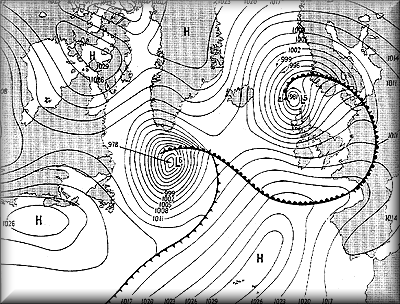Home
Royal Navy Instructor Officers
How Meteorology became part of
the Royal Navy
Origins | History | Development | World War 2 | D-Day Weather | D-Day Personalities
D-Day PersonalitiesD-Day: The Role of the Met. Office Extract: By the last week of May, the Supreme commander and his staff at his Southwick Park, near Portsmouth, headquarters knew that the weather was going to be the most important remaining unknown factor for the operation’s success. With increasing frequency the three armed Services’ met, representatives tried to bring together the views of the forecasting centres’ using “scrambled” telephone conferences, trying to foresee each critical weather element. They were Dr J M Stagg (RAF and Met. Office). Col Donald N. Yates, US Army Air Forces, his deputy, and Royal Navy Instructor Commander John Fleming, meteorologist to the Naval Cin- C Allied expeditionary Force. This team presented its assessments to Eisenhower, his Cs-in-C and their Chiefs of Staff. Comparing each of these “agreed forecasts”, the commanders learned how to assess them. Meteorology and D-Day, 6 June 1944 Some are weatherwise, some are otherwise. Benjamin Franklin (1706-1790) Extracts: Of all human activities, war is one of the most intense. And it is carried on in the open air. So wind and weather almost always play a part. For most recorded battles, the winning side has had the wind on its back. At sea, this became 'having the weather gauge‘; on land, with the wind on your back, your arrows, spears and stones fly farther and, with good planning, your opponent‘s fall short. At Towton, 1461, during the Wars of the Roses, snow blew into the losing, Lancastrian, side‘s eyes. Even during the cold war of the mid-20th-century, since upper winds blow mostly from the west, they would usually have carried nuclear fall-out clouds over western Europe back east . Had the Soviet Union waited for an unusual period of easterly upper winds, its occurrence should have raised the level of alertness in the west. Once the Supreme Commander had moved his HQ to Southwick House, near Portsmouth, a team of three attended the briefing, which was usually given by Group Captain Dr James Stagg RAFVR or his deputy Col. Don Yates USAAF, accompanied by Cdr. John Fleming RN. Between them, they wore the uniforms of the three arms, navy blue, khaki and light blue. Equally, they represented both the main allies Connected to Southwick House were forecasting teams at the Admiralty in London, where Royal Navy forecasters1 specialized in forecasting the state of the sea, at ETA in Dunstable, which had the forecasters with the greatest experience of UK weather, and at Bushey Park, near Teddington, the headquarters of the US Army Air Forces (known as Widewing) 1 Instructor Commanders G. M. Wolfe RN and John R. Thorp RN and Instructor Lieutenant Larry Hogben RNZN. Surface Map,D-Day June 6,1944
D-Day Operation Overlord Weather Group Captain John Stagg was appointed chief meteorologist to SHAEF in November 1943 to co-ordinate the meteorological arrangements for disseminating weather information and advice to the naval, army, and air forces, US and British under the Supreme Allied Commander's control. Each of the forces already had its own forecasters, but Stagg's job was to analyse their predictions and present the overall picture in a succinct form. His deputy was Colonel Donald N. Yates of the USAAF. Stagg travelled to Portsmouth from Widewing on Sunday, May 28, where he and Yates shared office space with Admiral Ramsey's chief weather officer, Instructor Commander John Fleming in a Nissen hut behind Southwick House. WATTS, Capt William Harold, RN (d 1997) Papers relating to Watts' RN career, training of RN Engineers and meteorology, 1945-1990, including three telegrams relating to the German and Japanese surrenders, May and Aug 1945, and to the signing of the Japanese surrender, Tokyo Bay, Japan, Sep 1945; lectures and talks by Watts relating to RN Engineer training, 1960-1962; typescript lecture notes entitled 'The Instructor Branch' [1961]; typescript address to Royal Naval Reserve Instructor Officers, [1964]; correspondence with R Adm Sir William (Alfred) Bishop, R Adm Christopher John Howard, Capt John Athol Burnett, RN, Capt Arthur Ernest Johnston, RN, Capt Alexander Malcolm Morrice, RN, Cdr William Nimmo Bowman, RN, and Richard J Ogden, Apr-Nov 1988, relating to research for a lecture by Watts on 'Meteorology in the Royal Navy in World War Two' to the History Group of the Royal Meteorological Society, Oct 1988, with edition of Meteorology and World War II. Second conference, October 1988, edited by Brian Douglas Giles (Royal Meteorological Society, School of Geography, University of Birmingham, Birmingham, 1989); typescript account of German bombing of HMS ILLUSTRIOUS off Pantelleria, Mediterranean, 10 Jan 1941, entitled 'A day to remember', with two sketch maps of the operation [1990]; typescript lecture notes on the organisation of the RN Meteorological Service in World War Two [1990]. http://www.aim25.ac.uk/cgi-bin/vcdf/detail?coll_id=226&inst_id=21 |
